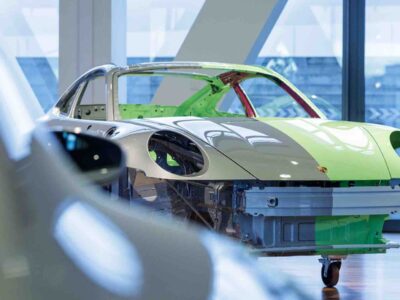Very few individuals are more closely intertwined with high-performance automotive design than Henrik Fisker. His storied career has brought him to the forefront of many of the most distinguished automotive design studios globally, including companies like BMW, Aston Martin, and Ford. Yet, his most notable contribution to the auto industry thus far came in 2011 with the production of the Fisker Karma, an exciting yet controversial luxury plug-in hybrid. Despite being just ahead of its time, it cemented the Fisker as an essential name in electrification.
As a company, Fisker is uniquely situated within the auto industry. It sits firmly between a startup and an established automotive company yet acts with the freedom to make choices as though they were either. On top of that, the company, led by Fisker himself, puts design at the forefront of every decision. This translates into a car that displays the technological machismo of a startup that fights for the same market segments as industry leaders. It contends with the big companies while pushing forward-thinking design that most industry leaders either can’t replicate or don’t.
The All-Electric Fisker Ocean: Goes The Distance
In 2021, 9 years after the brand stopped the production of the Karma, Fisker announced the release of a new vehicle: an all-electric SUV geared towards the masses that will hit the streets late this fall. The Ocean, as it’s known, has already garnered plenty of excitement and it’s not hard to see what.
This forward-thinking design is highlighted on the Ocean’s exterior. The car’s silhouette is sporty and futuristic, with the large 22” wheels contrasting with the body’s svelte shape in a way that is often not seen in sedans.
The result is a car that looks almost sculptural as if it’s still the clay studio model.
The sculpted side panels are shapely without any extra lines, giving the vehicle a surfer feel. Indeed, the only bold contouring lines found on the side panels are tracing the wheel wells and the deep trapezoidal cutout at the base of the doors. Both the front and back of the car feature thin light fixtures that accentuate the car’s sculpted shape. The headlights converge on an illuminated “Ocean” emblem at the car’s center below the Fisker logo. The same design cue is mirrored on the rear of the car.
The exterior was built with a few fun additions. On the luxury models, solar panels are integrated into the car’s roof, called the SolarSky. Rather than being sentenced to a fixed hardtop, the SolarSky roof slides back to reveal a generous sunroof. Those luxury models enjoy a feature known as “California Mode,” where the sunroof and seven windows fold down to enjoy a beautiful day on the road.
The interior also manages to subvert and reinvent some of the more conventional design trends in the budding EV market. As a whole, Fisker wanted the car to be the “world’s most sustainable vehicle,” making use of a variety of recycled materials for every aspect of the interior. They use recycled t-shirts for the dashboard, recycled fishing nets for the carpet, and have claimed that the interior is 100% vegan. The front seats are slightly different too. They have redesigned the seats to make them one integrated unit, with the headrests seamlessly a part of the seat itself. In terms of the control panel and dashboard, it’s pretty standard, with a digitized dashboard that can be toggled using the steering wheel and a touchscreen command center that can switch from landscape to portrait mode at the touch of a button.
In addition to the beautiful aesthetics, the Ocean is engineered to be one of the best in its class, challenging (and often beating) industry standards like the Tesla Model Y.
The Ocean’s battery maxes out at more than 350 miles on its Ocean One and Ocean Extreme models, with the potential for even more using its SolarSky roof panels. The Ocean can go 0-60mph in 3.6 seconds and it comes in at a whopping 550 horsepower at its most powerful. In addition, the car can recharge 200 miles in roughly 30 minutes at one of Electrify America’s charging ports, where owners will receive a not yet specified amount of complimentary charging.
All Fisker Ocean models have various driver-assistance features, including emergency braking, traffic light/sign recognition, and collision avoidance features. The Fisker Ocean starts at $37,499 with its Ocean Sport model, although with the tax credit, it may be as low as $30,000. The luxury models are priced at $49,999 and $68,999. The first deliveries are expected to come late this year, although the first 5,000 models are already spoken for.
The Fisker Ocean is one of the few cars that can balance beautiful design with intricate engineering while keeping the car at a very approachable price point. Its study in sustainability, engineering, and design is an incredible feat that will truly set the tone for electric vehicles in the future.





